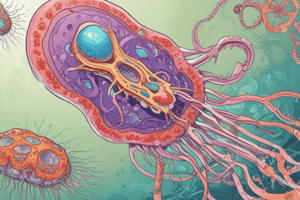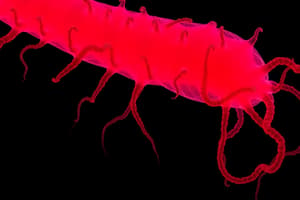Podcast
Questions and Answers
What is a common symptom of symptomatic extraintestinal amebiasis caused by Entamoeba histolytica?
What is a common symptom of symptomatic extraintestinal amebiasis caused by Entamoeba histolytica?
- Upper left abdominal pain
- Upper right abdominal pain (correct)
- Lower left abdominal pain
- Lower right abdominal pain
Which of the following flagellates is classified as a hemoflagellate?
Which of the following flagellates is classified as a hemoflagellate?
- Entamoeba histolytica
- Giardia intestinalis
- Trypanosoma (correct)
- Trichomonas vaginalis
Which characteristic is true of the trophozoite form of Giardia intestinalis?
Which characteristic is true of the trophozoite form of Giardia intestinalis?
- It is a dormant stage
- It has bilateral symmetry (correct)
- It contains no flagella
- It has three nuclei
How is infection with Giardia intestinalis primarily acquired?
How is infection with Giardia intestinalis primarily acquired?
What is the primary function of the sucking disc in the trophozoite of Giardia intestinalis?
What is the primary function of the sucking disc in the trophozoite of Giardia intestinalis?
What is a distinguishing feature of mature cysts of Giardia intestinalis?
What is a distinguishing feature of mature cysts of Giardia intestinalis?
Which of the following nutritional impacts may result from symptomatic extraintestinal amebiasis?
Which of the following nutritional impacts may result from symptomatic extraintestinal amebiasis?
During which stage of Giardia intestinalis's life cycle does excystation occur?
During which stage of Giardia intestinalis's life cycle does excystation occur?
Which symptom is NOT typically associated with symptomatic extraintestinal amebiasis?
Which symptom is NOT typically associated with symptomatic extraintestinal amebiasis?
What does encystation lead to in the life cycle of Giardia intestinalis?
What does encystation lead to in the life cycle of Giardia intestinalis?
What is the primary illness caused by Entamoeba histolytica?
What is the primary illness caused by Entamoeba histolytica?
Which stage of Entamoeba histolytica can be recognized by its spherical shape and presence of multiple nuclei?
Which stage of Entamoeba histolytica can be recognized by its spherical shape and presence of multiple nuclei?
What characteristic is unique to the trophozoite stage of Entamoeba histolytica?
What characteristic is unique to the trophozoite stage of Entamoeba histolytica?
Which of the following statements about the life cycle of Entamoeba histolytica is true?
Which of the following statements about the life cycle of Entamoeba histolytica is true?
How is Entamoeba histolytica typically transmitted?
How is Entamoeba histolytica typically transmitted?
Which of the following is NOT a clinical symptom associated with amebic dysentery?
Which of the following is NOT a clinical symptom associated with amebic dysentery?
What is the term for individuals who carry Entamoeba histolytica but show no clinical symptoms?
What is the term for individuals who carry Entamoeba histolytica but show no clinical symptoms?
What is a possible complication of extra-intestinal amebiasis involving the liver?
What is a possible complication of extra-intestinal amebiasis involving the liver?
Which of the following is a feature of mature Entamoeba histolytica cysts?
Which of the following is a feature of mature Entamoeba histolytica cysts?
What is the role of houseflies and cockroaches in the transmission of Entamoeba histolytica?
What is the role of houseflies and cockroaches in the transmission of Entamoeba histolytica?
Flashcards
Entamoeba histolytica
Entamoeba histolytica
A parasite causing intestinal infections, ranging from asymptomatic carrier states to severe dysentery and extra-intestinal infections.
Intestinal amebiasis
Intestinal amebiasis
An infection of the intestines by Entamoeba histolytica.
Amebic dysentery
Amebic dysentery
A severe intestinal infection causing bloody or pus-filled stools.
Trophozoite
Trophozoite
Signup and view all the flashcards
Cyst
Cyst
Signup and view all the flashcards
Excystation
Excystation
Signup and view all the flashcards
Transmission Routes
Transmission Routes
Signup and view all the flashcards
Asymptomatic Carrier State
Asymptomatic Carrier State
Signup and view all the flashcards
Amebic colitis
Amebic colitis
Signup and view all the flashcards
Extra-intestinal amebiasis
Extra-intestinal amebiasis
Signup and view all the flashcards
Entamoeba histolytica symptoms
Entamoeba histolytica symptoms
Signup and view all the flashcards
Giardia intestinalis
Giardia intestinalis
Signup and view all the flashcards
Giardia trophozoite
Giardia trophozoite
Signup and view all the flashcards
Giardia cyst
Giardia cyst
Signup and view all the flashcards
Giardia life cycle stage
Giardia life cycle stage
Signup and view all the flashcards
Intestinal flagellates
Intestinal flagellates
Signup and view all the flashcards
Giardia intestinalis cysts
Giardia intestinalis cysts
Signup and view all the flashcards
Transmission of Giardia
Transmission of Giardia
Signup and view all the flashcards
Giardiasis
Giardiasis
Signup and view all the flashcards
Study Notes
Foodborne Intestinal Parasites
- Foodborne intestinal parasites are a concern for public health.
- Various parasites cause intestinal disease, including Entamoeba histolytica, Giardia intestinalis, and Taenia.
- Ascaris lumbricoides is also a parasite that causes intestinal issues.
Entamoeba histolytica
-
Causes intestinal disease:
- Intestinal amebiasis: intestinal infection.
- Amebic dysentery: invasion of intestinal mucosa.
- Extra-intestinal amebiasis: infection of organs outside the intestine.
-
Morphology:
- Trophozoites: Exhibits rapid, unidirectional movement using pseudopods.
- Contains a single nucleus.
- Can contain red blood cells, bacteria, yeast, and other debris in the cytoplasm. E. histolytica is the only intestinal amoeba that exhibits this.
- Cysts: Are spherical to round and smaller than trophozoites.
- Mature cysts contain 1-4 nuclei (quadrinucleated)
- Red blood cells, bacteria, and yeast are not found in the cyst stage.
- Trophozoites: Exhibits rapid, unidirectional movement using pseudopods.
-
Life Cycle:
- Once the infective cyst is ingested, excystation occurs in the small intestine.
- A single cyst produces motile trophozoites that settle in the large intestine and replicate.
- Trophozoites can migrate to other organs like the liver, potentially causing abscess formation (extra-intestinal amebiasis).
- Encystation occurs and cysts are released in human feces. Cysts are very resistant to various environmental conditions.
-
Epidemiology:
- Transmission routes include ingestion of cysts in food.
- Houseflies and cockroaches can be vectors by spreading cysts on unprotected food.
- Improperly treated water supplies can spread the infection.
-
Clinical Symptoms:
- Infected patients can be asymptomatic (asymptomatic carrier state).
- Amebic colitis: An intestinal infection characterized by diarrhea, abdominal pain, and cramping.
- Amebic dysentery: A condition marked by blood and/or pus and mucus in the stool.
- Symptomatic Extraintestinal Amebiasis: Abscess formation in the right lobe of the liver leads to upper right abdominal pain, fever, nausea, and potential vomiting.
- Intestinal damage and malabsorption can also occur, leading to diarrhea, nutrient loss, impact on appetite and food intake, anemia, and/or micronutrient deficiencies.
The Flagellates
- Categorized into groups:
- Intestinal flagellates (Giardia intestinalis)
- Urogenital flagellates (Trichomonas vaginalis)
- Hemoflagellates (Trypanosoma and Leishmania spp)
- Movement via flagella in their trophozoite form.
Giardia intestinalis
-
Description: Intestinal flagellate that colonizes and reproduces in the small intestine.
-
Causes: Diarrheal illness known as giardiasis, also known as "traveler's diarrhea" in less-developed countries.
-
Morphology:
- Trophozoites: Motile stage with bilateral symmetry (similar anatomical parts on opposite sides).
- Two nuclei.
- Four pairs of (8) flagella.
- Sucking discs for attachment and nourishment.
- Cysts: Typical oval with a thick cell wall.
- Immature cysts contain two nuclei
- Mature cysts (infective stage) contain four nuclei
- Trophozoites: Motile stage with bilateral symmetry (similar anatomical parts on opposite sides).
-
Life Cycle:
- Infection occurs via ingestion of cysts in contaminated water, food, or the fecal-oral route (hands).
- In the small intestine, excystation releases trophozoites which attach to the mucosa.
- Encystation occurs in the colon.
- Trophozoites are detected in diarrheal feces. Cysts are more common in formed (non-diarrheal) feces.
-
Impact on Nutrition:
- Malabsorption of nutrients, interfering with absorption of carbohydrates, fats, proteins, fat-soluble vitamins (A, D, E).
- Leads to nutritional deficiencies.
- Lactose intolerance due to intestinal damage.
- Chronic diarrhea and nutrient loss, leading to weight loss, appetite loss, delayed cognitive development and learning difficulties.
- Disruption of gut microbiota and immune function.
Studying That Suits You
Use AI to generate personalized quizzes and flashcards to suit your learning preferences.





